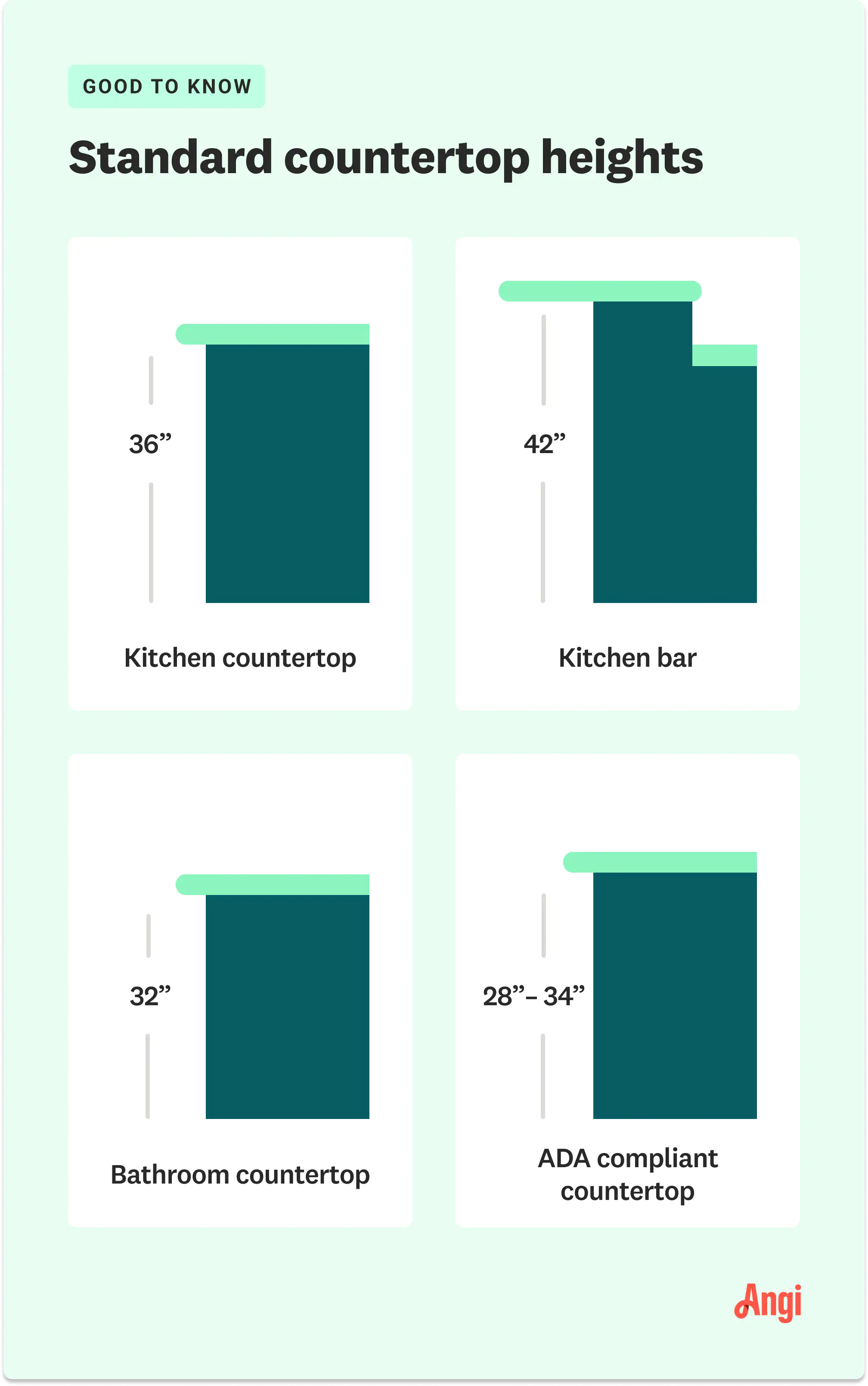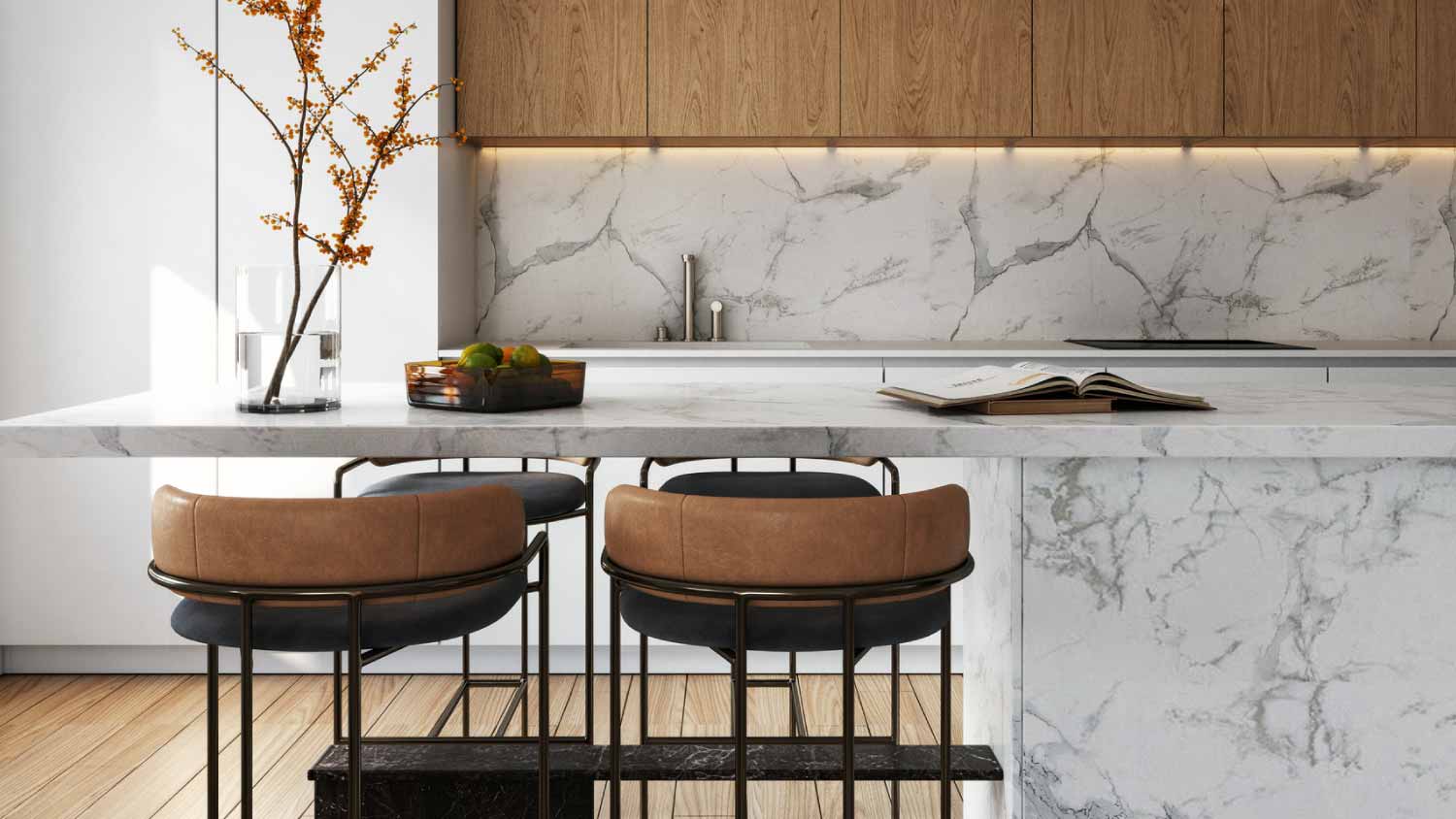
The cost of stainless steel countertops may seem shocking compared to laminate, but their durability may be worth it. Here’s how much you can expect to spend.
You must be this tall to chop


The standard countertop height in a kitchen is 36 inches, which accommodates a cabinet height of 34.5 inches and a countertop thickness of 1.5 inches.
Bathroom and table-height countertops are shorter than the standard, while bar-height countertops are taller.
When choosing a countertop height, consider the countertop's purpose, your physical requirements, and your home’s resale value.
Kitchen countertops see a lot of action, including food prep, cooking, cleaning, homework, and even socializing. Having the right height kitchen countertops is imperative for your comfort and ensuring your kitchen is user-friendly. But what is the standard countertop height, and why? This guide explores the different countertop heights and how to choose the right height for your kitchen countertops.

The standard countertop height in a kitchen is 36 inches or three feet. This is said to be the ideal height for people between 5’4” and 5’9”. However, the best countertop height for you could differ from the standard based on your height and the intended purpose of the countertop.
Let’s look at the different types of countertops and their typical heights so you can better plan your kitchen design.
| Countertop Type | Height in Inches |
|---|---|
| Standard kitchen | 36 |
| Tabletop | 28–30 |
| Bar | 41–43 |
| Bathroom | 32–36 |
A standard kitchen countertop measures 36 inches in height. Kitchen base cabinets are usually 34.5 inches tall, and most countertop materials are 1.5 inches thick. This is the typical counter height in most kitchens, so unless you request a different height, a contractor will install countertops at three feet high.
A countertop that sits at tabletop height is usually between 28 and 30 inches high. This type of counter is rarer to see in a kitchen, but some people choose to have one installed as a kitchen table alternative in place of a dining table for better flow in an open kitchen/dining area.
Bar-height countertops are more common seating options. They are between 41 and 43 inches high and often have stools as seating. Bar-height countertops are great for eating, working, or socializing.
Bathroom countertops typically stand 32 inches tall. However, because this height may be too short for some people, you can find bathroom countertops as tall as 36 inches.
Determine the best countertop height for you by measuring how tall your elbows are from the ground. The ideal countertop height is between three and four inches below your elbows to minimize the strain on your back and shoulders while you’re chopping, cooking, and doing the dishes. If that height is around 36 inches, you should be fine with a standard-height countertop. Otherwise, consider installing countertops that are slightly shorter or taller than the standard height.

Several factors will help you decide on the right countertop height for your kitchen or bathroom.
First and foremost, you’ll need to consider the purpose of your countertop. A standard countertop height should suffice if you plan to use it for food prep. If you want to add areas in your kitchen where you can work or eat, adding tabletop-height and bar-height countertops might be beneficial.
Finally, in a bathroom, choose the height that works best for your height and the heights of the home’s other residents. If you’re considering bar height vs. counter height countertops, you might have room for both in your kitchen.
Standard countertops measure 36 inches tall. That height is intended for users between 5’4” and 5’9”. If you’re much shorter or taller than this, you may need to adjust your counter height so you’re not straining while cooking. Wheelchair users typically require a lower counter height of 34 inches to fit their wheelchairs underneath while cooking.
Ideally, the countertop will hit three to four inches below your elbow for food prep, five to six inches below your elbow for cooking, and eight inches below your elbow for rolling dough or kneading bread. Julia Child’s kitchen countertops were actually raised by two inches to accommodate her height.
If you plan to deviate from the standard countertop height of 36 inches, consider how it will affect your home’s resale value. Tall homeowners might appreciate a slightly higher countertop, but potential buyers might see the deviation as a disadvantage if you plan to sell your home. For those staying in their home long-term, choose a countertop height that will work best for you rather than worrying about resale value.
If you have countertops installed in your home that are the wrong height, you’ll need to hire a countertop contractor near you to raise or lower them. Attempting to do this yourself is dangerous; countertops are heavy and bulky, and you may need to cut or replace the cabinets to change the countertop height.
Unless you plan on a kitchen remodel, consider trying to live with your current countertops for now. Once you’re ready to remodel and have the budget for kitchen remodeling costs, you can have your cabinets and countertops replaced together at a height that best suits you.
When it comes to kitchen remodels, countertops and cabinets are the two most commonly updated features. According to responses from 206,600 Angi customers, 23.9% of homeowners requested countertops be moved or installed, while 22.8% made the same request for cabinets. These numbers highlight the central role both elements play in kitchen design, as updating them can significantly improve the space's functionality and style.
From average costs to expert advice, get all the answers you need to get your job done.

The cost of stainless steel countertops may seem shocking compared to laminate, but their durability may be worth it. Here’s how much you can expect to spend.

Discover the cost of installing laminate countertops, including how their size, material, and finish impact your total price.

If you’re looking to refinish your countertops, epoxy will make them shine for years to come. This guide will help you budget for epoxy countertop costs.

If your kitchen needs a facelift, you can give your outdated counters a new life by learning how to paint Formica® countertops.

Is this trendy material all it’s cracked up to be? Not if it cracks from a poor installation! This guide will help you weigh concrete countertop pros and cons.

Learn about the pros and cons of Dekton countertops to decide if this highly durable material is best for your indoor or outdoor kitchen.